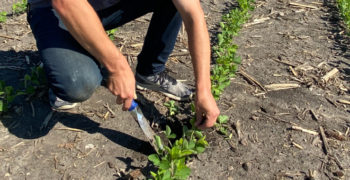by Champion Seed Soybean Agronomist Rob Thomas
Controlling weeds in soybean fields in 2022 could be more challenging than ever. Rising prices, ongoing transportation problems and herbicide supply shortages will make weed control more difficult. To reduce the occurrence of weed resistance to the effective herbicide tools we have left in our toolbox, growers must use multiple modes of action, residuals, apply herbicides timely and use full rates. Repeated applications of the same herbicide, year-after-year, can result in weed resistance.
At Champion Seed, we’ve seen a significant shift to Enlist® Soybeans for 2022. It’s possible that shift is due to the continued off-target movement of Dicamba in 2021 and a shortage of Liberty® herbicide for 2022. The concern for this rapid adoption of Enlist Soybeans is that we may see greater weed resistance to 2,4-D.
Supplies of Enlist 2,4-D Colex-D and Dicamba herbicides both seem to be good for 2022. However, Liberty, which is very commonly used in Enlist and XtendFlex® Soybean herbicide programs, is tough for soybean producers to get their hands on. Glyphosate supplies are tight as well, and that limits our options for controlling grasses in soybean fields. The shortage of glyphosate and glufosinate will most likely result in growers relying on fewer modes of action to control weeds, possibly contributing to future weed resistance.
XtendFlex soybean producers normally apply Dicamba in their first herbicide pass and then apply Liberty, or a Liberty/glyphosate combination on their second herbicide application. This is because XtendFlex Soybeans cannot be sprayed with Dicamba products after soybeans have begun flowering. Also, most states do not allow the use of Dicamba after June 30th. With Liberty (glufosinate) and glyphosate herbicides in short supply, the herbicides readily available for that second pass are now quite limited. A good thing to note about making that first herbicide pass with Dicamba, is that Dicamba does have 10 or more days of residual, whereas Enlist has no residual.
Enlist soybean growers enjoy a wider spraying window with Enlist Colex-D. It can be applied to soybeans up to R2 or full bloom. However, larger weeds can be harder to kill than with Dicamba. Its best to spray weeds with Enlist soybean fields when weeds are 6” or less. A “half-kill” is one way that we contribute to weed resistance issues.
With the tight supply of glyphosate, growers may turn to more clethodim to control grasses. Know that tank mixing clethodim with Enlist Colex-D herbicide reduces the effectiveness of the clethodim. Increasing the clethodim rates and adding herbicides in the appropriate mixing sequence will improve its efficacy. Corteva provides a convenient chart for determining clethodim tank mix rates.
Tank mixing herbicides with different modes of action is one of the most important tactics producers can use in the battle against resistant weeds. Be sure to check approved tank mix partner lists for the herbicides you plan to use. Also look for tank mixing sequences, as that can be a critical step in having effective weed control across the field. Almost all tank mixing procedures can be found online or on the herbicide label.
Pre-Emergence herbicides with residual is one of the most effective practices soybean growers can implement to keep weeds guessing. Not only does pre-emergence provide another mode of action, but they also normally provide residual control of emerging weeds. The use of residual’s in pre-emergence applications will make subsequent herbicide applications more effective by suppressing weeds longer and increasing the time between herbicide applications. No matter which soybean trait producers choose to plant or which over-the-top herbicides they choose to apply, the use of pre-emergence herbicides with residuals is the key to successful weed control program in 2022.



